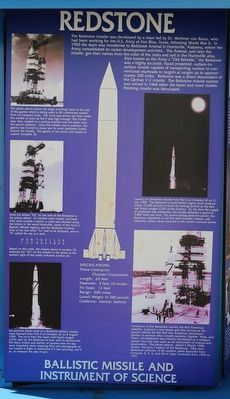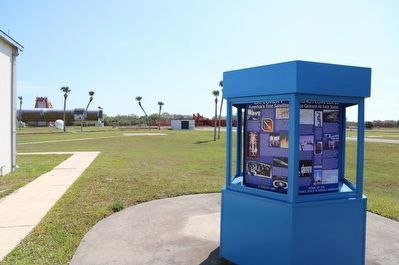Cape Canaveral in Brevard County, Florida — The American South (South Atlantic)
Redstone
Ballistic Missile and Instrument of Science
The Redstone missile was developed by a team led by Dr. Werner von Braun, who had been working for the U.S. Army at Fort Bliss, Texas, following World War II. In 1950 the team was transferred to Redstone Arsenal in Huntsville, Alabama, where the Army consolidated Its rocket development activities. The Arsenal, and later the missile, got their names from the color of the rocks and soil in the Huntsville area. Also known as the Army's "Old Reliable," the Redstone was a highly accurate, liquid propelled surface-to-surface missile capable of transporting nuclear or conventional warheads to targets at ranges up to approximately 200 miles. Redstone was a direct descendant of the German V-2 missile. The Redstone missile system was retired in 1964 when the faster and more mobile Pershing missile was developed.
(captions)
The photo above shows the large overhead crane at the top of the gantry which is being used to lift a Redstone missile from its transport truck. The truck was driven out from under the missile as soon as the it was high enough. The missile was then rotated to a vertical position and set down onto the launch platform. Once the missile was in position, the gantry was moved in closer and its work platforms closed around the missile. The gantry in the photo still stands at Lunch Complex 26.
Launch of a Redstone missile from Pad-A at complex 26 on 21 July 1959. The Redstone’s liquid-fueled engine could produce nearly 75,000 pounds of thrust by burning alcohol as the fuel, and liquid oxygen (LOX) as the oxidizer. By the time the supply of propellant was exhausted, the missile obtained a speed of 3,800 miles per hour. For control during powered ascent, the Redstone depended on tail fins with movable rudders, and refractory carbon vanes mounted in the rocket’s exhaust plume.
Note the letters “NS” on the side of the Redstone in the photo above. To number each missile, yet keep their total number a secret, a code was devised using the letters in the word Huntsville, home of th e Army’s Ballistic Missile Agency and the Redstone Arsenal. One of the two letter “Ls” had to be dropped, and an “X” added for use as a zero.
1 2 3 4 5 6 7 8 9 0
Specifications:
Prime Contractor: Chrysler Corporation
Length: 63 feet
Diameter: 5 feet 10 inches
Fin Span: 12 feet
Range 200 miles
Launch Weight: 61,000 pounds
Guidance: Inertial, ballistic
Ice particles break loose as a Redstone ballistic missile roars skyward from Pad-A at Complex 26 on 4 August 1959. The ice is from the super cold liquid oxygen (LOX) used by the Redstone to burn with its alcohol fuel. The black striped and pattern of squares near the top were important when studying films and photographs of the missile in flight to determine if it was spinning, and if so, to measure the rate of spin.
Variations of the Redstone carried the first American satellite, Explorer I, into space and also served as the launch vehicle for the first two American astronauts. Similar to several other missile systems, (Jupiter, Atlas, and Titan), the Redstone was initially developed as a weapon system but was also used as an instrument of science and exploration. The photo above, dated 5 March 1958, shows the Juno I variant of Redstone. Fifty-nine Redstone vehicles, of all variants, were launched from Complex 4, 5, 6, and 26 at Cape Canaveral from 1953 to 1961.
Erected by Cape Canaveral Space Force Museum.
Topics. This historical marker is listed in these topic lists: Air & Space • Science & Medicine. A significant historical year for this entry is 1950.
Location. 28° 26.637′ N, 80° 34.326′ W. Marker is in Cape Canaveral, Florida, in Brevard County. Marker is on Museum Circle south of Lighthouse Road, on the left when traveling south. Touch for map. Marker is at or near this postal address: 191 Museum Cir, Cape Canaveral FL 32920, United States of America. Touch for directions.
Other nearby markers. At least 8 other markers are within walking distance of this marker. Juno II (here, next to this marker); Jupiter (here, next to this marker); Launch Complex 26 (here, next to this marker); Explorer I (here, next to this marker); a different marker also named Launch Complex 26 (a few steps from this marker); a different marker also named Launch Complex 26 (within shouting distance of this marker); a different marker also named Launch Complex 26 (within shouting distance of this marker); First United States Space Launch (within shouting distance of this marker). Touch for a list and map of all markers in Cape Canaveral.
Also see . . . Cape Canaveral Space Force Museum. (Submitted on March 8, 2023.)
Credits. This page was last revised on March 8, 2023. It was originally submitted on March 8, 2023, by Dave W of Co, Colorado. This page has been viewed 94 times since then and 16 times this year. Photos: 1, 2. submitted on March 8, 2023, by Dave W of Co, Colorado. • Bernard Fisher was the editor who published this page.

